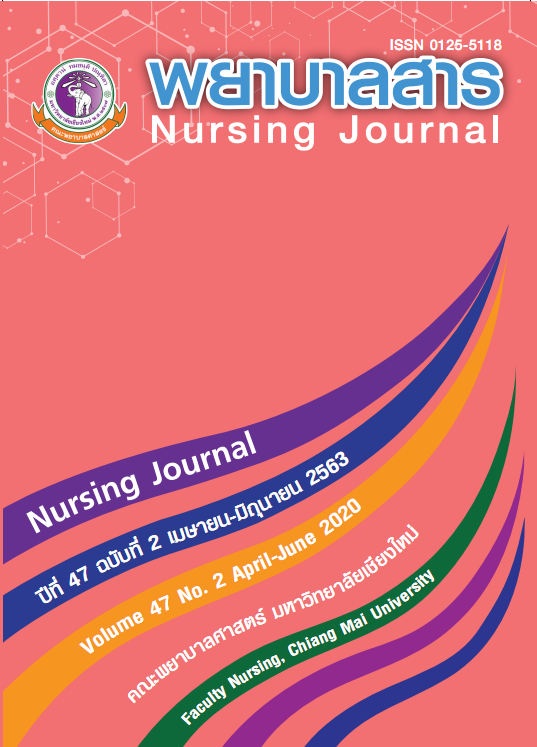Nurses’ Practices in Response to Preterm Infant Cues During Daily Care
Keywords:
Nurses’ Practices, Response to Infant Cues, Preterm, Daily CareAbstract
Preterm infants admitted to Neonatal Intensive Care Unit should receive appropriate nursing care according to principle of developmental care for preterm infants. Nurses should be able to assess preterm infant cues and respond appropriately nursing activities for infants to console themselves to stability. This study aims to survey practices of nurses in response to preterm infant cues during daily care. A purposive sample was ten nurses working in a Neonatal Intensive Care Unit or Nursery Unit. Instrument was the observation form of nurses’ practices in response to preterm infant cues during daily care. Data was analyzed using percentages of the nursing practices.
It was found that two nursing activities providing daily care were taking vital signs such and body cleaning. Nurse responded to the preterm infant cues obviously in two subsystems, autonomic and motor subsystems. Most nurses responded by stopping the nursing activities to infants’ physiological cues; changing heart rate and oxygen saturation less than 88 %. Most nurses responded by swaddling and facilitated tucking to motor cues included arms, legs, and body over stretched or flexed; back arched; body twisted; face covered; finger sprayed; fist clenched; grimace; twitched; and fuzzy. The results of this study can be information for enhancing nurse’s understanding and concerns regarding response to preterm infant cues during daily care.
References
Als, H. (1982). Toward a synactive theory of developmental: Promise for the assessment and support infant individuality. Infant Mental Health Journal, 3(4), 229–243.
Als, H. (1986). A synactive model of neonatal behavioral organization: Framework for the assessment of neurobehavioral development in the premature infant and for support of infants and parents in the neonatal intensive care environment. Physical & Occupational Therapy in Pediatrics, 6(3-4), 3-53.
Altimier, L. B., Eichel, M., Warner, B., Tedeschi, L., & Brow, B. (2004). Developmental care: Changing the NICU physically and behaviorally to promote patient outcomes and contain costs. Neonatal Intensive Care, 17(2), 35–39.
Ballweg, D. (2007). Neonatal and pediatric pain management: standards and application.Pediatric and Child Health, 17, S61-S66.
Blackburn, S. T. (2007). Maternal, fetal, & neonatal physiology: a clinical perspective (3rd ed.):St. Louis Missouri: Saunders Elsevier.
Bureau of Policy and Strategy, Office of the Permanent Secretary. (2014). Number and Fertility Rate per 1,000 Female, by Age Group of Mother, 2006-2010, Retrieved from http://bps.ops.moph.go.th/Healthinformation/statistic53/2.1.2_53.pdf (In Thai)
Epstein, E. (2005). Toward anew conceptualization for stress response in newborn infants.Newborn and Infant Nursing Review, 5(2), 97–103.
Gardner, S. L., & Lubchenco, L. O. (1998). The neonate and the environment: Impact on development. In G. B. Merenstein & S. L. Gardner (Eds.), Handbook of neonatal intensive care (pp. 211–212). St. Louis: Mosby.
Herlihy, B., & Maebius, N. K. (2003). The human body in health and illness (2nd ed.). Louis:Saunders.
Holditch-Davis, D., Blackburn, S. Y., & Vanderberg, K. (2003). Newborn and infant neurobehavioral development. In C. Kenner & J. W. Lott (Eds.). Comprehensive neonatal nursing (3rd ed., pp.236-278). Philadelphia: Saunders.
Holditch-Davis, D., & Blanckburn, S. T. (2007). Neurobehavioral development. In C. Kenner & J. W. Lott (Eds.), Comprehensive neonatal nursing (4th ed., pp. 448-479). St. Louis: Saunders.
Holsti, L., Grunau, R. E., Oberlander, T. F., & Whitfield, M. F. (2005). Prior pain induces heightened motor responses during clustered care in preterm infants in the NICU. Early Hum Dev, 8(3),293-302.
Inthapan, J. (2001). Handing Received by Premature Infants in Neonatal Intensive Care Unit (Master’s thesis, Chiangmai University). (In Thai)
Lester, B. M., Miller, R. J., Hawes, K., Salisbury, A., Bigsby, R., Sullivan, M. C., & Padbury, J. F.(2010). Infant Neurobehavioral Development. Seminars in Perinatology, 35, 8-19. Liaw, J. J., Yang, L., Yuh, Y. S., & Yin, T. (2006). Effects of tub bathing procedures on preterm infants’ behavior. Journal of Nursing Research, 14(4), 297-304.
Limperopoulos, C., Gauvreau, K. K., O’Leary, H., Moore., M., Bassan, H., Eichenwald, E. C., ...Plessis, A. J. (2008). Cerebral hemodynamic changed during intensive care of preterm infants. Pediatrics, 122(5), 1006-1013.
Nakklinkul, P. (2003). Effect of quiet hour provision on sleep period of premature infants. (Master’s thesis, Chiangmai University). (In Thai)
Plupphol, W. (2008). Effects of noise reduction cap usage on stress responses of premature infants in the neonatal in tensive care unit (Master’s thesis, Chiangmai University). (In Thai)
Ramsay, D., & Lewis, M. (2003). Reactivity and regulation in cortisol and behavioral to stress. Child Development, 74(2), 456–464.
Rick, S. L. (2006). Developmental care on newborn intensive care unit: Nurse’s experiences and neurodevelopmental, behavioral, and parenting outcome. A critical review of the literature. Journal of Neonatal Nursing, 12, 56-61.
Sengphanit, T. (2007). Stress Signals of Premature Infants Receiving Non-Invasive Care. (Master’s thesis, Chiangmai University). (In thai)
Sirikunsatian, V. (2013). Pattern of stress responses among preterm infants while receiving daily nursing care: Nursing Journal, 40(1), 127-139. (In Thai)
Solhaug, M., Bjork, I. T., & Sandtro, H. P. (2012). Staff perception one year after implementation of the newborn individualized developmental care and assessment program (NIDCAP).Journal of Pediatric Nursing, 25(2), 89-97.
Smith, J. R. (2012), Comforting touch in the very preterm hospitalized infant: an integrative review. Advances in Neonatal, 12(6), 349–365.
Symington, A., & Pinelli, J. (2005). Developmental care for promoting development and preventing morbidity in preterm infants. Cochrane Library: Cochrane Reviews, 2.
Traut, W. R., Wink, T., Minehart, T., & Davis, D. H. (2012). Frequency of premature infant engagement and disengagement behaviors during two maternally administered intervention. Newborn & Infant Nursing Reviews, 12(3), 124–131.
World Health Organization. (2012). 15 Million babies born too soon. Retrieved from http://www.who.int/mediacentre/news/releases/2012/preterm_20120502/en/
Downloads
Published
How to Cite
Issue
Section
License
บทความที่ได้รับการตีพิมพ์เป็นลิขสิทธิ์ของวารสารพยาบาลสาร
ข้อความที่ปรากฏในบทความแต่ละเรื่องในวารสารวิชาการเล่มนี้เป็นความคิดเห็นส่วนตัวของผู้เขียนแต่ละท่านไม่เกี่ยวข้องกับมหาวิทยาลัยเชียงใหม่ และคณาจารย์ท่านอื่นๆในมหาวิทยาลัยฯ แต่อย่างใด ความรับผิดชอบองค์ประกอบทั้งหมดของบทความแต่ละเรื่องเป็นของผู้เขียนแต่ละท่าน หากมีความผิดพลาดใด ๆ ผู้เขียนแต่ละท่านจะรับผิดชอบบทความของตนเองแต่ผู้เดียว






